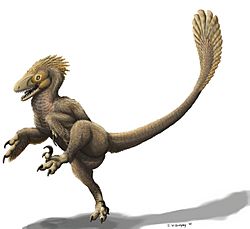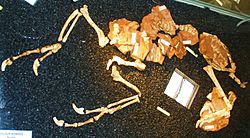Balaur facts for kids
Quick facts for kids BalaurTemporal range:
Upper Cretaceous, 70 mya |
|
|---|---|
 |
|
| Balaur bondoc displaying its double sickle claws in a kicking action |
|
| Scientific classification | |
| Kingdom: | |
| Phylum: | |
| Class: | |
| Superorder: | |
| Order: | |
| Suborder: | |
| Infraorder: | |
| Superfamily: |
Dromaeosauroidae
|
| Family: | |
| Genus: |
Balaur
|

Balaur is a very interesting type of dinosaur called a dromaeosaurid. These dinosaurs were theropods, which means they walked on two legs and were usually meat-eaters. Balaur lived in what is now southern Europe about 70 million years ago. This was during the Upper Cretaceous period, the last part of the dinosaur age.
What makes Balaur special is its feet. Unlike most other dromaeosaurs, it had two large, curved claws on each foot, not just one. These are often called "sickle claws" because of their shape. It also had a very small third finger that probably didn't work very well.
Discovery and Habitat
Scientists first discovered Balaur in 2010. This dinosaur lived on a large prehistoric island called Hateg Island. Seventy million years ago, the sea levels were much higher than they are today. Because of this, Europe was not a single landmass but many different islands.
Balaur lived on one of these islands. Being isolated from other dinosaurs might have caused it to develop its unique features. It was a relatively small dinosaur, measuring about 1.8–2.1 metres (5.9–6.9 ft) long. This smaller size is an example of something called island dwarfism. This happens when animals on islands evolve to be smaller than their relatives on the mainland.
Species and Relatives
There is only one known species of this dinosaur, which is called Balaur bondoc. Scientists have studied Balaur and found that it is closely related to the famous Asian dromaeosaurid, Velociraptor. Both Balaur and Velociraptor belong to a group called velociraptorines.
Images for kids
See also
 In Spanish: Balaur para niños
In Spanish: Balaur para niños


